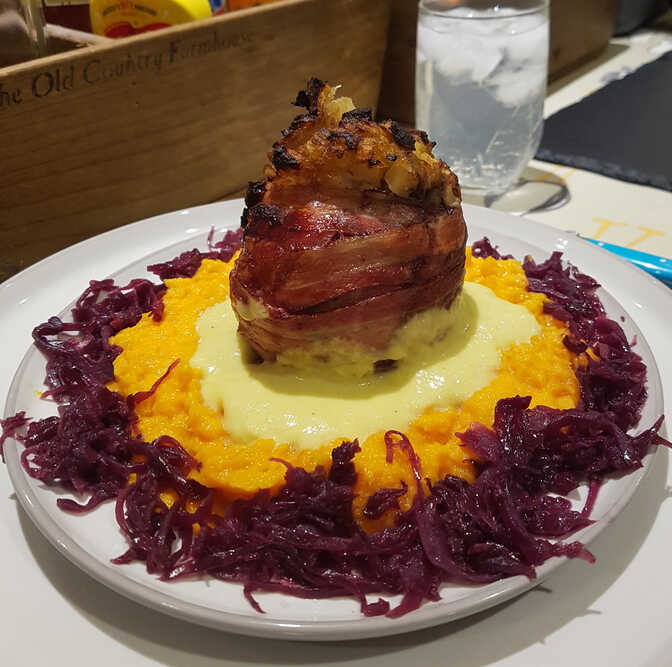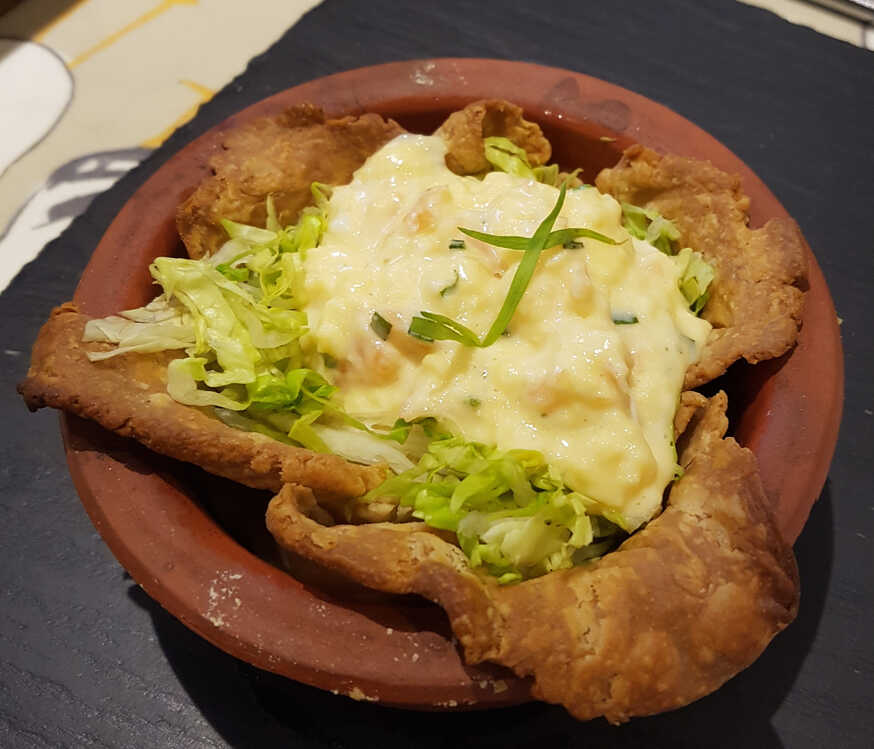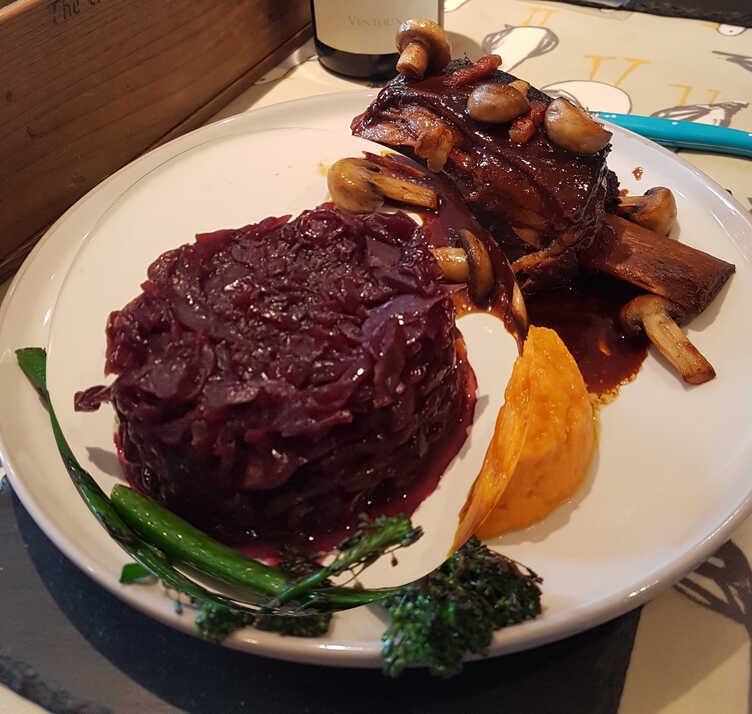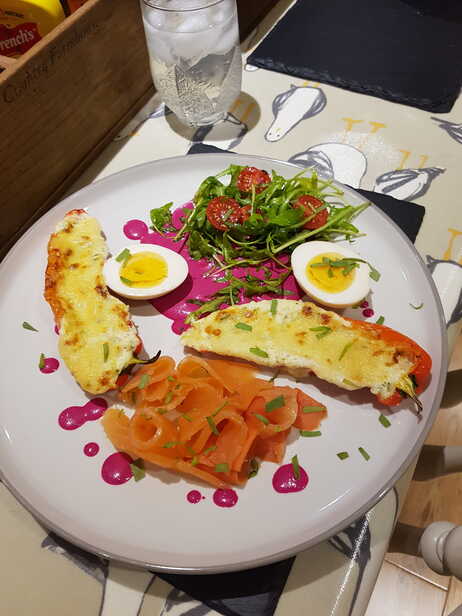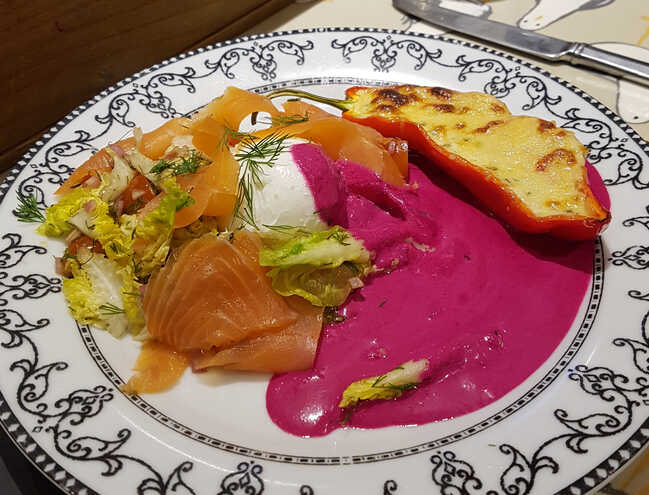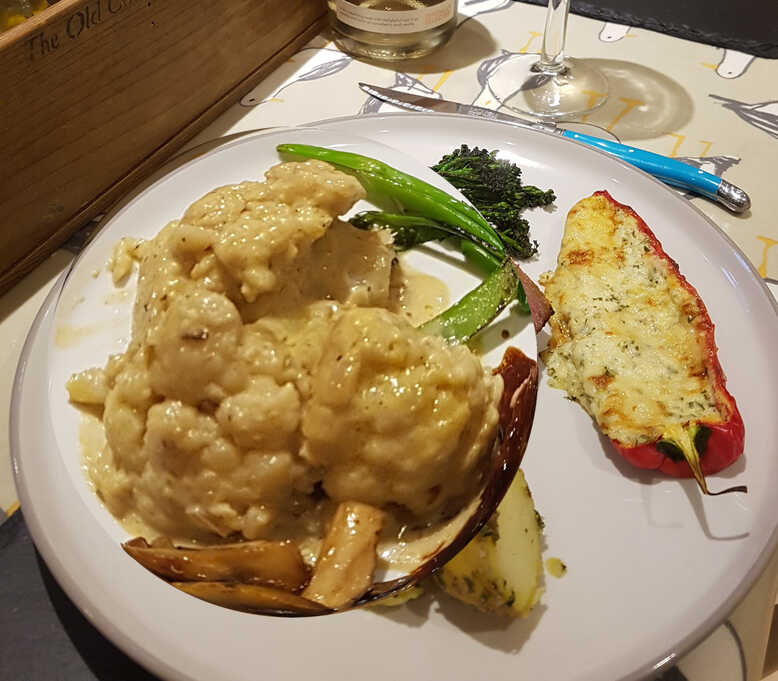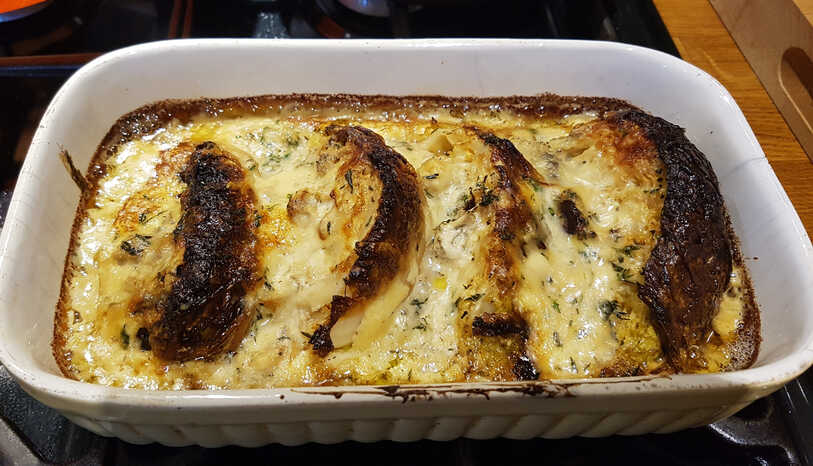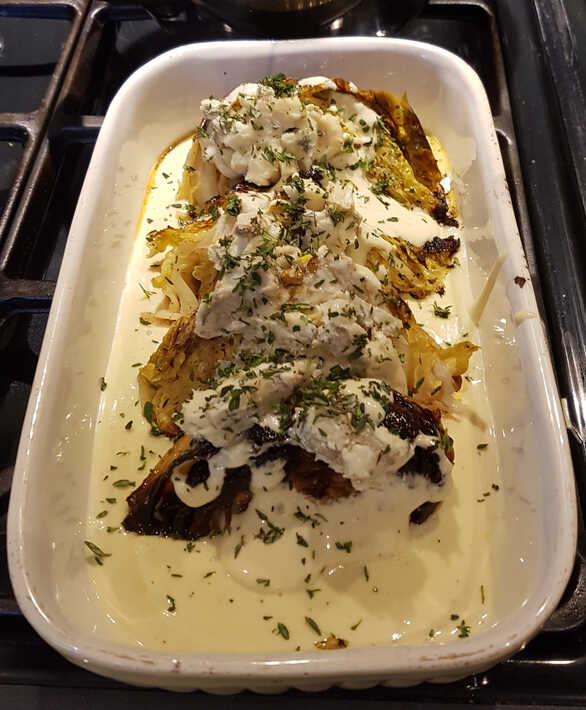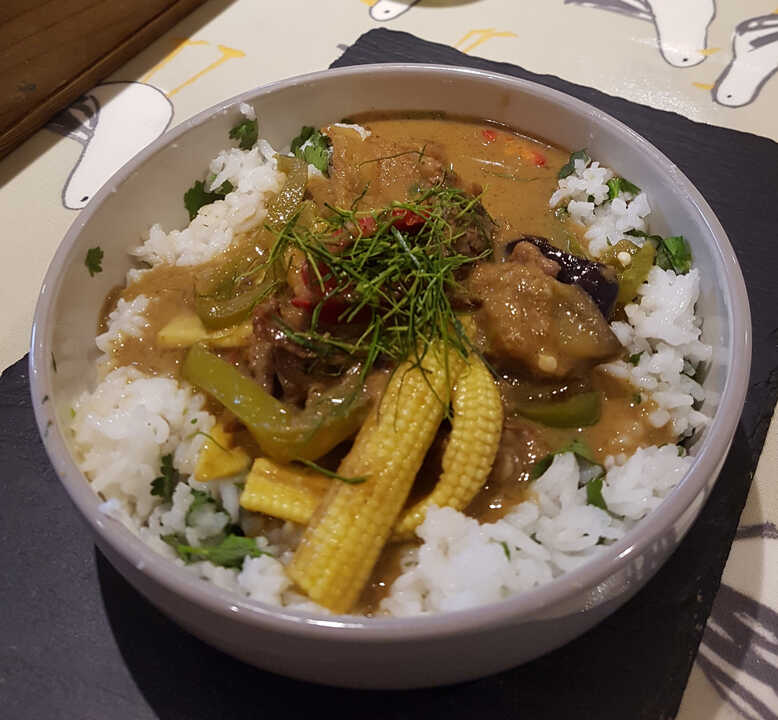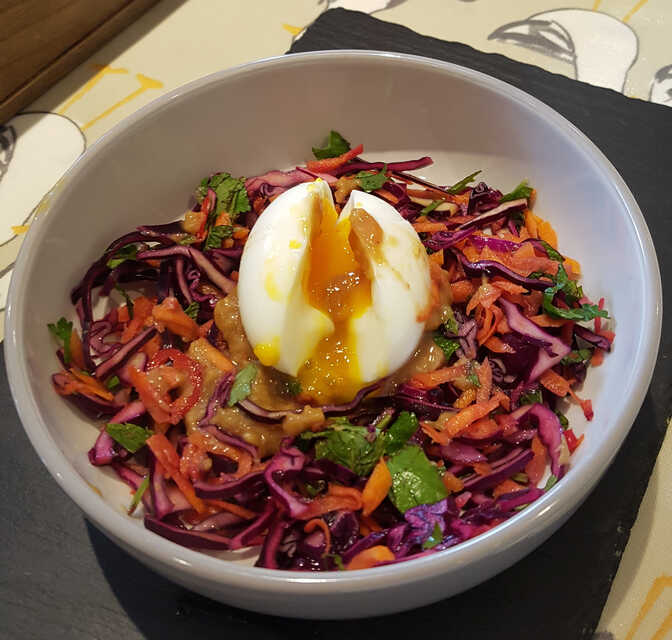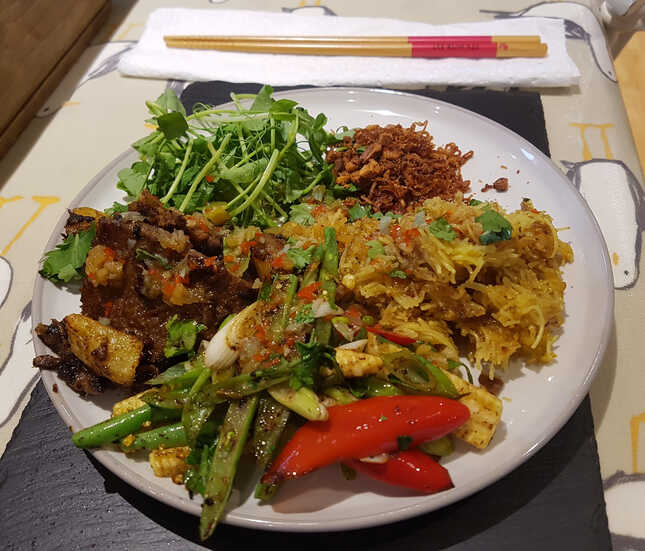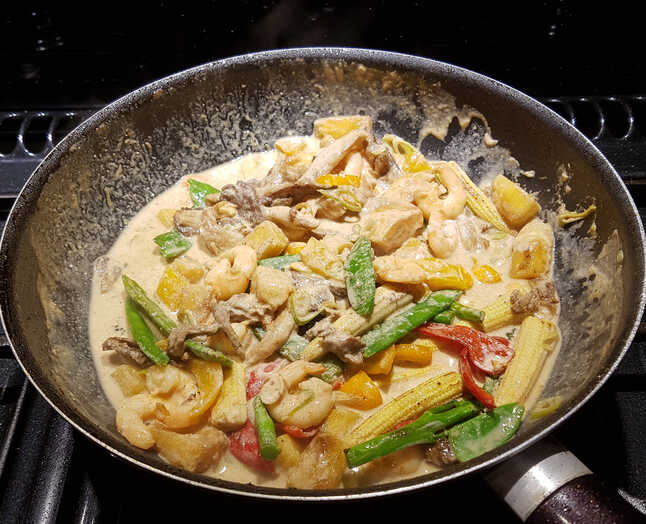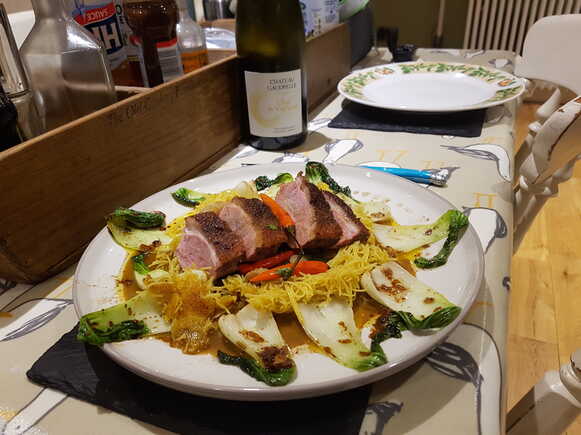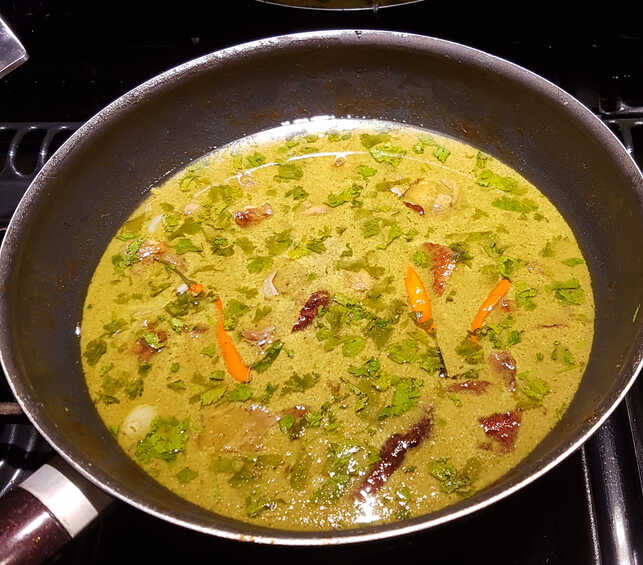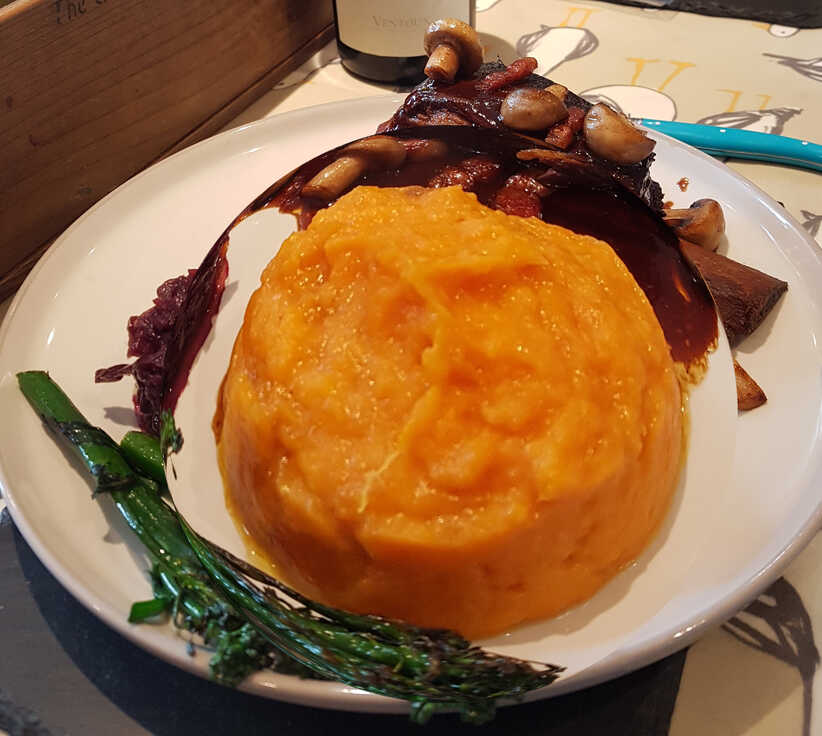
Have a Heart

I blame the cider.
Sometimes, when I visit meat-town I have a complete and extensive shopping list and know exactly what I'm cooking.
And sometimes I have no idea, and wander around aimlessly seeking for inspiration. This time inspiration arrived in the form of cider. As I suspect is often true in the prelude to a tractor crash or a haystack fire.
Anyhoo, my local Wine'n'Cheese happened to have some champagne-style cider bottles for sale. Which I thought intriguing, since I wasn't sure how it might differ from regular cider Nor am I now - I thought this was how all cider was made! so I bought some, then went to the butcher to see what he had that might go with it.
Turned out he had pig's heart.
So that's what's for dinner.
Apple Stuffed Heart
main meat
Well, I found a bottle of Champagne-Style cider in the local Wine'n'Cheese store.
And the rest is history.
Serves 2
Ingredients
- knob butter
- 2 shallots minced
- 2 cloves garlic, minced
- 1 Bramley apple, peeled, cored, chopped
- 1-2 cups cider
- streaky bacon
- 2 pig's hearts
- salt, pepper, sugar to season
Optional Flavourings:- lemon or lime zest
- herbs, e.g. thyme, tarragon, dill
Heat a generous knob of butter in a small pan and sweat the minced shallots until they collapse.
Add the garlic and sweat until it softens.
Add more butter as required. Peel, core and chop the Bramley or other cooking apple into 1cm pieces.
Add it to the pan and stir until it is nicely coated in the butter. Add the cider and cook off until you have a thick, chunky apple sauce.
Season the stuffing, sweeten it if necessary, and add any herbs you fancy. Perhaps tarragon or thyme. Maybe lime or lemon zest?
Hollow out the hearts by cutting out the fat blood vessels in a cone shape from the top. Avoid removing too much pure, smooth muscle.
Season inside the heart with salt and pepper.
Fill the hearts with the apple mixture and pile it up out the top. Roll the back of a knife along each bacon slice to stretch it, then use them to wrap the heart from the bottom to the top. This will secure any cuts or breaks in the heart wall. You can extend the sides upwards to help contain the stuffing, but don't go over the top 🙂
Stand the hearts upright in an oven-proof dish using ramekins, or crumpled foil or baking paper. Bake them for 1½-2 hours until the bacon is crisped, the heart cooked through, and the stuffing caramelised at the top.
Add more butter as required. Peel, core and chop the Bramley or other cooking apple into 1cm pieces.
Add it to the pan and stir until it is nicely coated in the butter. Add the cider and cook off until you have a thick, chunky apple sauce.
Season the stuffing, sweeten it if necessary, and add any herbs you fancy. Perhaps tarragon or thyme. Maybe lime or lemon zest?
Hollow out the hearts by cutting out the fat blood vessels in a cone shape from the top. Avoid removing too much pure, smooth muscle.
Season inside the heart with salt and pepper.
Fill the hearts with the apple mixture and pile it up out the top. Roll the back of a knife along each bacon slice to stretch it, then use them to wrap the heart from the bottom to the top. This will secure any cuts or breaks in the heart wall. You can extend the sides upwards to help contain the stuffing, but don't go over the top 🙂
I used smoked bacon.
Pre-heat the oven to Gas Mark 3.Stand the hearts upright in an oven-proof dish using ramekins, or crumpled foil or baking paper. Bake them for 1½-2 hours until the bacon is crisped, the heart cooked through, and the stuffing caramelised at the top.
They go well with a leek and orange sauce, sweet potatoes with apricots and cider-braised red cabbage.
Extra Leek Sauce
veg sauce experimental
I made up some creamed leeks the other day, and started thinking about how to make it into a smoother sauce.
So I boiled the leeks up with milk then blended that before whisking it into a roux.
But that didn't work: Insufficiently leeky.
Obviously the flavour needs to be concentrated beforehand, so I sweated the leeks in butter first, before blending with milk (and cream), then whisking into a roux, and that was better.
But it occurs to me that you might be able to juice the leeks and use their liquor for an even more concentrated sauce?
You can add spring onions or chives to the mixture too, by the way. And of course a touch of garlic.
Ground white pepper still seems to be the best flavouring (maybe epazote?), but I haven't tried adding cheese, or cream cheese to this sauce yet.
Might be overkill.
So I boiled the leeks up with milk then blended that before whisking it into a roux.
But that didn't work: Insufficiently leeky.
Obviously the flavour needs to be concentrated beforehand, so I sweated the leeks in butter first, before blending with milk (and cream), then whisking into a roux, and that was better.
But it occurs to me that you might be able to juice the leeks and use their liquor for an even more concentrated sauce?
Well, you can juice leeks and reduce the liquor to add to this sauce, but it's not terribly nice if I'm honest - a bit on the bitter side.
Also you can throw a small orange into the juicer with the leeks, which gives an interesting flavour twist, though it doesn't help at all with the bitterness.
Also you can throw a small orange into the juicer with the leeks, which gives an interesting flavour twist, though it doesn't help at all with the bitterness.
You can add spring onions or chives to the mixture too, by the way. And of course a touch of garlic.
Ground white pepper still seems to be the best flavouring (maybe epazote?), but I haven't tried adding cheese, or cream cheese to this sauce yet.
Might be overkill.
I'm unsure how to get more leek-flavour into the sauce without the bitterness that comes from juicing them?
Definitely a work in progress.
Definitely a work in progress.
Ingredients
- leeks, chopped
- milk/cream mixture
- leek juice
- butter
- flour
Optional Flavours:- ground white pepper
- spring onions
- garlic
- epazote
- chives
- orange(!)
Sweat a large quantity of chopped leeks in butter until much reduced, then blend with enough cream and milk to make a sauce.
If you want you can try loosening the mixture with leek juice, straining, then using this to thicken and flavour a blond roux.
If you want you can try loosening the mixture with leek juice, straining, then using this to thicken and flavour a blond roux.
Throw in extra flavourings (like ORANGE) as you like.
Sweet Potato with Apricots
side veg
An inspired combination of flavours, if I say so myself.
The only trouble is that they're both the same colour, so you can't tell what you're eating.
Perhaps it's worth trying with parsnips, or yams or something?
The only trouble is that they're both the same colour, so you can't tell what you're eating.
Perhaps it's worth trying with parsnips, or yams or something?
Ingredients
- sweet potatoes
- apricots
- butter
- cream
- salt & pepper
Halve the apricots, discard the stone, then cut each half in four.
Slide a knife under each segment to remove the skin. Cut into small chunks.
Prick the sweet potatoes and bake them until they are soft and goopy.
Peel them, mash them with a generous knob of butter and a hefty splash of cream.
Season.
Stir through the apricots pieces.
Slide a knife under each segment to remove the skin. Cut into small chunks.
Prick the sweet potatoes and bake them until they are soft and goopy.
Peel them, mash them with a generous knob of butter and a hefty splash of cream.
Season.
Stir through the apricots pieces.
Excellent!
Braised Red Cabbage with Apple and Cider
side veg vegan
To be honest I didn't like the cinnamon, and the champagne cider was rather bitter.
But it was edible.
But it was edible.
Serves 4
Ingredients
- large knob of butter
- 1 small red cabbage
- 1 sliced red onion
- 2-3 garlic cloves
- 2 tblsp brown sugar, or to taste
- 2 tblsps cider vinegar
- granny smith apples, peeled, cored, chopped
- 300ml cider
- 1 cinnamon stick
Peel off the outer leaves from the cabbage and discard. Quarter the cabbage, removing the tough stem, then thinly slice.
Thinly slice the red onion and the garlic.
Peel, core and roughly chop the apple.
Mix everything together with the brown sugar, and the cider in an oven-proof pot.
Bubble the cider in a small pan until it has reduced by two-thirds and add to the pot.
Season and add the cinnamon stick.
Dot with the butter, bring to a boil, cover, then gently simmer or cook in a low oven for 1½-2 hours until tender.
Stir occasionally.
You may need to uncover for the last 30 minutes to reduce the sauce.
Thinly slice the red onion and the garlic.
Peel, core and roughly chop the apple.
Mix everything together with the brown sugar, and the cider in an oven-proof pot.
Bubble the cider in a small pan until it has reduced by two-thirds and add to the pot.
Season and add the cinnamon stick.
Dot with the butter, bring to a boil, cover, then gently simmer or cook in a low oven for 1½-2 hours until tender.
Stir occasionally.
You may need to uncover for the last 30 minutes to reduce the sauce.
Meh.
Short Ribs Slow-Braised in Red Wine
main meat
Well, braised in a red wine reduction anyway.
Daniel Gritzer over at Serious Eats reckons you should reduce a whole bottle of port to finish the sauce. Well, I didn't have that much spare port - all mine is worth drinking so much too expensive to use a whole bottle on cooking.
But hey, don't let me stop you!
You will need a very rich stock, otherwise you should add more gelatine to give the sauce that deliciously unctuous mouth feel.
I got a couple of massive calves' knees (or elbows?) from the butcher which did the job very nicely.
Though it takes a good few hours of simmering and then reducing in a huge pot. Probably one joint would have been enough.
Don't make the mistake of trying to skim off all the lovely gelatine mistaking it for fat at the end though.
Daniel Gritzer over at Serious Eats reckons you should reduce a whole bottle of port to finish the sauce. Well, I didn't have that much spare port - all mine is worth drinking so much too expensive to use a whole bottle on cooking.
But hey, don't let me stop you!
You will need a very rich stock, otherwise you should add more gelatine to give the sauce that deliciously unctuous mouth feel.
I got a couple of massive calves' knees (or elbows?) from the butcher which did the job very nicely.
Though it takes a good few hours of simmering and then reducing in a huge pot. Probably one joint would have been enough.
Don't make the mistake of trying to skim off all the lovely gelatine mistaking it for fat at the end though.
Serves 4
Ingredients
- olive oil, for frying
- 4 thick-cut meaty beef short ribs
- 1 large head of garlic, cut in half horizontally
- 1 heaped tbsp tomato purée
- 1 x 750ml bottle red wine
- 1 litre concentrated beef stock
- 150g pancetta lardons
- 150g small chestnut mushrooms, trimmed and halved
- Sea salt and freshly ground black pepper
- Chopped flat leaf parsley, to garnish
- 1-2 celery ribs, cut into ½" dice
- 1-2 carrots, cut into ½" dice
- 2 onions, cut into ½" dice
- thyme
- bay leaves
- 1 tblsp soy sauce
- 1 tblsp fish sauce
- extra field mushrooms, sliced optional
Preheat the oven to 170°C/Gas Mark 3.
Make sure the stock is thick and gelatinous, or reduce it some more too.
Heat a deep-sided roasting tray on the hob and add a glug of olive oil. Use an ovenproof pot with a lid, if you're cooking overnight.
Season the short ribs thoroughly, then fry for 10–15 minutes to brown really well on all sides.
Remove and set aside.
Add the halved garlic head, cut sides down, pushing them to the bottom of the pan until it nicely browns. Add them to the ribs.
Fry the onions and the carrots until they begin to caramelize, add the celery and fry until it begins to wilt.
Add the soy sauce and the fish sauce and the thyme and bay leaves and return the ribs and garlic. I may have added a splash of balsamic vinegar too, I'm not sure.
Add stock to nearly cover the ribs (you may not need all the stock).
Taste, adjust the seasoning if required mine needed a little more soy sauce.
Bring to the boil again, basting the ribs with the juices.
Cover the roasting tray with foil and cook in the preheated oven for 3–4 hours, basting now and then until the meat is tender and falling away from the bone.
Drain off any excess fat. Mix the mushrooms with the pancetta (and some chopped parsley).
When the short ribs are ready, remove from the oven and transfer to a warmed serving dish.
Scoop out the garlic, squeeze the cloves out of their skins and press them through a sieve into a saucepan.
Spoon off as much excess fat from the beef cooking liquid as you can manage there will be a lot of fat, then strain the sauce into the saucepan too, and reduce it for 10-15 minutes if it's a little thin.
Discard the pressed out vegetables remaining in the sieve.
Serve the short ribs topped with the hot pancetta and mushrooms and the sauce poured around.
Garnish with chopped flat leaf parsley.
Or the lowest possible setting if you're cooking overnight.
Say Gas Mark ¼/100°C.
Reduce the wine to a third in a saucepan.Make sure the stock is thick and gelatinous, or reduce it some more too.
Heat a deep-sided roasting tray on the hob and add a glug of olive oil. Use an ovenproof pot with a lid, if you're cooking overnight.
Season the short ribs thoroughly, then fry for 10–15 minutes to brown really well on all sides.
Remove and set aside.
Add the halved garlic head, cut sides down, pushing them to the bottom of the pan until it nicely browns. Add them to the ribs.
Fry the onions and the carrots until they begin to caramelize, add the celery and fry until it begins to wilt.
I added my extra sliced mushrooms here, but they do release a lot of water and take so long to dry off that everything else burns. Perhaps they're best fried separately or first, and decanted?
I'm not really sure how much they contributed anyway - they had retained an awful lot of flavour even by the end of my cooking.
Add the tomato purée and sweat for a minute or two to cook it out. Pour in the wine and some stock to deglaze the pan, scraping up the bits at the bottom.I'm not really sure how much they contributed anyway - they had retained an awful lot of flavour even by the end of my cooking.
Add the soy sauce and the fish sauce and the thyme and bay leaves and return the ribs and garlic. I may have added a splash of balsamic vinegar too, I'm not sure.
Add stock to nearly cover the ribs (you may not need all the stock).
Taste, adjust the seasoning if required mine needed a little more soy sauce.
Bring to the boil again, basting the ribs with the juices.
Cover the roasting tray with foil and cook in the preheated oven for 3–4 hours, basting now and then until the meat is tender and falling away from the bone.
Or cook overnight or 8-10 hours on the lowest oven setting.
Turn the ribs when you can.
About 10 minutes before the short ribs are ready to serve, fry the pancetta for 2–3 minutes until crisp and golden.
But not too crisp - which is easy to do if the pan is too hot and the lardons are too small.
About 1cm cross-section fat cubes or rectangles seems about right.
Start the pan on a low to medium heat until the lardons are just beginning to render, cooked through, and golden on the outside. But not hard!
Scoop them into a bowl, turn the heat up under the pan, add the chestnut mushrooms and cook for 4–5 minutes, shaking regularly, until tender.Start the pan on a low to medium heat until the lardons are just beginning to render, cooked through, and golden on the outside. But not hard!
Drain off any excess fat. Mix the mushrooms with the pancetta (and some chopped parsley).
When the short ribs are ready, remove from the oven and transfer to a warmed serving dish.
Scoop out the garlic, squeeze the cloves out of their skins and press them through a sieve into a saucepan.
Spoon off as much excess fat from the beef cooking liquid as you can manage there will be a lot of fat, then strain the sauce into the saucepan too, and reduce it for 10-15 minutes if it's a little thin.
Discard the pressed out vegetables remaining in the sieve.
It's much easier to remove the fat if you've cooked the ribs well ahead of time by leaving the strained, but un-reduced sauce in the fridge or freezer until the fat sets.
Then scraping it off the top.
To serve, now reduce the sauce in a pot while you re-warm the ribs in a little juice back in the casserole (or covered roasting tin) in a Gas Mark 3 oven.
To serve, now reduce the sauce in a pot while you re-warm the ribs in a little juice back in the casserole (or covered roasting tin) in a Gas Mark 3 oven.
Serve the short ribs topped with the hot pancetta and mushrooms and the sauce poured around.
Garnish with chopped flat leaf parsley.
Truly magnificent!
Who needs bottles of reduced port?
Who needs bottles of reduced port?
Roast Peppers Stuffed with Cream Cheese
starter side veg cheese
I used long, thin, pointy, sweet red peppers and they had a good balance of pepper and filling.
I should think fat bell peppers would be overwhelmed by the creamy cheese stuffing, not to mention the expense in Boursin, and I doubt green ones would work so well either, but try them if you like.
I added a small - so as not to make the mix too sloppy splash of cream to my mixture to make it easier to work with, but I don't think you really need to.
Feel free to mix in anything else you like - some of the grated cheese topping, extra minced peppers, or perhaps some chopped smoked salmon!
I should think fat bell peppers would be overwhelmed by the creamy cheese stuffing, not to mention the expense in Boursin, and I doubt green ones would work so well either, but try them if you like.
I added a small - so as not to make the mix too sloppy splash of cream to my mixture to make it easier to work with, but I don't think you really need to.
Feel free to mix in anything else you like - some of the grated cheese topping, extra minced peppers, or perhaps some chopped smoked salmon!
Serves 2 or 4
Ingredients
- 2 long peppers
- 150g Boursin
- 1 shallot or handful of spring onions
- splash of double cream optional
- extra herbs, chopped optional
- parmesan or gruyère, grated
Preheat the oven to Gas Mark 6/200°/400°F.
Split the peppers lengthways and cut away the core, pith and seeds, whilst retaining a length of stalk.
Mince the onion and any herbs you fancy adding, if your cream cheese is insufficiently herbed already. I added some tarragon, since I had lots on hand.
Beat in the cream cheese, adding a splash of cream to loosen the mixture, if you like.
Drizzle a little oil into an oven dish, just enough to stop the peppers drying out and sticking, lay in the peppers skin-side down, spoon in the cream cheese mixture and level it off.
Split the peppers lengthways and cut away the core, pith and seeds, whilst retaining a length of stalk.
Mince the onion and any herbs you fancy adding, if your cream cheese is insufficiently herbed already. I added some tarragon, since I had lots on hand.
Beat in the cream cheese, adding a splash of cream to loosen the mixture, if you like.
Drizzle a little oil into an oven dish, just enough to stop the peppers drying out and sticking, lay in the peppers skin-side down, spoon in the cream cheese mixture and level it off.
Try and keep the peppers horizontal in the dish or the toppings will ooze out.
You might use piles of salt or strategically crumpled tin foil.
Dress with a grating of melty cheese and bake for 15-20 minutes until the tops colour up nicely.
Actually don't use salt. When the filling bubbles out it will then become hopelessly contaminated!
Rather good. And very adaptable.
Beetroot and Hot Smoked Anchovy Dressing
fish dressing
I don't actually remember if I added some Boursin or not.
It won't do any harm though.
It won't do any harm though.
Ingredients
- a dozen hot smoked anchovies
- 2 garlic cloves
- juice of a couple of satsumas or clementines
- 1 birds eye chilli, de-seeded
- 1 cooked beetroot
- 1 tsp Forvm chardonnay vinegar, or to taste
- Boursin or other creamed cheese maybe
- 1 tsp balsamic vinegar, or to taste
- a drizzle of olive oil
- a few spoonfuls of double cream
Blend everything together except for the oil and the cream.
Use just enough orange juice to lubricate the purée.
Finally blend in a drizzle of oil to make a smooth, glossy sauce.
Stir in a little cream to loosen the dressing.
Use just enough orange juice to lubricate the purée.
Finally blend in a drizzle of oil to make a smooth, glossy sauce.
Stir in a little cream to loosen the dressing.
Really great consistency - a rich, thick dressing that also photographs well.
If you're the kind of shallow web chef who cares about such things 🙄
If you're the kind of shallow web chef who cares about such things 🙄
Cauliflower Blue Cheese
side veg cheese
You really can't have too many cauliflower cheese recipes. Right?
Serves 4
Ingredients
- 1 small cauliflower, leaves removed
- 1 red onion or 4 shallots, minced
- a few garlic or black garlic cloves
- 250ml double cream and milk
- 1-2 tblsps flour
- 8 oz blue cheese
Cut the cauliflower into florets with their long stalks attached.
or separate the stalks and start them cooking first.
Par-cook in salted water until easily penetrated with a knife and drain.
Remove the stalks and blend with enough milk to lubricate.
Sweat the minced onions or shallots in oil and butter without browning.
Add minced garlic or squish in a few black garlic cloves.
Add 1-2 tablespoons of flour and cook until it turns, and smells, nutty.
First blend in the puréed cauliflower stalks, then gradually add double cream with a splash or two of milk as necessary until it thickens to a sauce.
Stir through chopped blue cheese and the par-cooked cauliflower florets.
Par-cook in salted water until easily penetrated with a knife and drain.
Remove the stalks and blend with enough milk to lubricate.
Sweat the minced onions or shallots in oil and butter without browning.
Add minced garlic or squish in a few black garlic cloves.
Add 1-2 tablespoons of flour and cook until it turns, and smells, nutty.
First blend in the puréed cauliflower stalks, then gradually add double cream with a splash or two of milk as necessary until it thickens to a sauce.
Stir through chopped blue cheese and the par-cooked cauliflower florets.
I didn't bake or grill this, in the way of regular cauliflower cheese, though I suppose you could. You might risk it splitting though.
In any case you'd probably want to scatter a grated melty cheese (cheddar, parmesan or gruyère I suppose) and/or some breadcrumbs on top to make a nice crust.
In any case you'd probably want to scatter a grated melty cheese (cheddar, parmesan or gruyère I suppose) and/or some breadcrumbs on top to make a nice crust.
Whole Roasted Cabbage with Gorgonzola Cream
side cheese
Apparently this recipe is from Philadelphia's Lo Spiedo restaurant,
which is heavily invested in charring.
I made this using half a Savoy cabbage roasted cut-side down, which worked just fine. I also made the sauce with cream rather than milk and enjoyed the resulting rich sauce.
I made this using half a Savoy cabbage roasted cut-side down, which worked just fine. I also made the sauce with cream rather than milk and enjoyed the resulting rich sauce.
Serves 8
Ingredients
- 1 green cabbage
- about ¼ cup olive oil for seasoning
- salt and freshly ground black pepper
- 2 oz crumbled gorgonzola, preferably picante
- 2 tablespoons chopped parsley
- 2 teaspoons chopped rosemary
- 2 teaspoons chopped thyme
For the Sherry Vinaigrette:- 1 tblsp olive oil
- 1 tblsp grapeseed oil
- 2 tsps sherry vinegar
For the Gorgonzola Sauce:- 4 oz gorgonzola
- ¼ cup grapeseed oil
- ¼ cup olive oil
- ½ cup whole milk or double cream!
- 1 tblsp sherry vinegar
Preheat oven to 450°F/Gas Mark 8.
In a roasting pan, season cabbage generously with olive oil, salt and pepper.
Place cabbage in oven and roast, turning occasionally, until charred on outside and tender within, about 3 hours.
Meanwhile, Make Sherry Vinaigrette:
In a large bowl, mix 1 tablespoon olive oil and 1 tablespoon of grapeseed oil with 2 teaspoons Sherry vinegar until combined. Season with salt and pepper to taste. Set aside.
Make gorgonzola sauce:
Mix ¼ cup each of olive and grapeseed oil.
In a small sauce pan over medium heat, heat milk cream! to just below boiling. In a blender, purée hot milk cream! and 4 oz of gorgonzola until smooth. While motor is running, slowly drizzle in the mixed olive-grapeseed oil. Stir in sherry vinegar, and season with salt and pepper. Set sauce aside.
Transfer cooked cabbage to a wire rack set over a baking sheet. Let cool 15–20 minutes. Slicing vertically through the core, cut cooled, cooked cabbage into 8 wedges, leaving core intact in each wedge.
Line the bottom of a large baking dish with the gorgonzola sauce, place cabbage on top, and garnish with remaining gorgonzola and herbs.
Return cabbage to oven. Bake until sauce is bubbling and cheese has melted, 5–6 minutes.
Sounds like a long time at 450°. Certainly my half-cabbage was done in 1½ hours.
Meanwhile, Make Sherry Vinaigrette:
In a large bowl, mix 1 tablespoon olive oil and 1 tablespoon of grapeseed oil with 2 teaspoons Sherry vinegar until combined. Season with salt and pepper to taste. Set aside.
Make gorgonzola sauce:
Mix ¼ cup each of olive and grapeseed oil.
In a small sauce pan over medium heat, heat milk cream! to just below boiling. In a blender, purée hot milk cream! and 4 oz of gorgonzola until smooth. While motor is running, slowly drizzle in the mixed olive-grapeseed oil. Stir in sherry vinegar, and season with salt and pepper. Set sauce aside.
Transfer cooked cabbage to a wire rack set over a baking sheet. Let cool 15–20 minutes. Slicing vertically through the core, cut cooled, cooked cabbage into 8 wedges, leaving core intact in each wedge.
You should also strip off the outer couple of layers of burned leaves.
Toss cabbage with Sherry vinaigrette and season with salt and pepper.Line the bottom of a large baking dish with the gorgonzola sauce, place cabbage on top, and garnish with remaining gorgonzola and herbs.
Return cabbage to oven. Bake until sauce is bubbling and cheese has melted, 5–6 minutes.
It's pretty good, but there's a lot of faff involved for the result.
I mean - could you really taste the three hours of cabbage char underneath all that smothering gorgonzola?
You might achieve much the same result by boiling the cabbage, then grilling the dressed wedges.
And what's with the two oils? Just pick an oil and stick with it!
And what's with the two oils? Just pick an oil and stick with it!
Thai Green Curry Beef
thai main meat curry
Serves 4-6Ingredients
- 2 tbsp coconut or rapeseed or sunflower oil
- 3-4 tblsps green curry paste
- 750g rib-eye or sirloin steak
- 1 cup beef stock
- 500ml coconut milk
- 150g baby corn, halved
- 1 green or red pepper
- 1 tin bamboo shoots
- 1 aubergine
- 1-2 tblsps fish sauce
- 1-2 tblsps palm sugar
- zest of 1 lime
To Finish:- handful kaffir lime leaves, shredded
- 4 long mild red chillies, sliced
- handful Thai basil or coriander, roughly chopped
Chill the beef in the freezer to stiffen it.
Slice across the grain into fat strips, about 1mm wide.
Core and slice the pepper.
Halve the baby corns.
Trim off the ends and cut the aubergine into 1" chunks.
Drain the bamboo shoots.
Trim the stalks from the lime leaves, and shred the rest.
Roughly chop the Thai basil or coriander.
Heat the oil in a wok and add the fat floating on the top of the coconut cream. Once it's bubbling add the green curry paste and cook it until the oil separates. Add the beef in batches, so as not to lose the pan's heat, and cook through.
Add the pepper and stir through.
Add the baby corns and stir through.
Add the remaining coconut milk, the palm sugar, the lime zest, the fish sauce and the stock.
Add the bamboo shoots, and bring everything to a simmer.
Dress with sliced red chillies, the shredded lime leaves, the basil or coriander leaves and serve with jasmine rice.
Slice across the grain into fat strips, about 1mm wide.
Core and slice the pepper.
Halve the baby corns.
Trim off the ends and cut the aubergine into 1" chunks.
Drain the bamboo shoots.
Trim the stalks from the lime leaves, and shred the rest.
Roughly chop the Thai basil or coriander.
Heat the oil in a wok and add the fat floating on the top of the coconut cream. Once it's bubbling add the green curry paste and cook it until the oil separates. Add the beef in batches, so as not to lose the pan's heat, and cook through.
If the beef is very fatty, or is a tougher cut, it may be best to fry the strips separately in oil first.
Add the aubergines and stir through.Add the pepper and stir through.
Add the baby corns and stir through.
Add the remaining coconut milk, the palm sugar, the lime zest, the fish sauce and the stock.
Add the bamboo shoots, and bring everything to a simmer.
Dress with sliced red chillies, the shredded lime leaves, the basil or coriander leaves and serve with jasmine rice.
Not bad. A workmanlike Thai curry.
I was thinking of throwing some cooked potatoes in there too for bulk.
Thai-Style Red Cabbage Salad
salad thai veg
Thai Basil would be best in this Thai-style salad.
Or just use whatever herb combination you have/fancy.
Serves 4
Ingredients
- ½ red cabbage
- 2-4 long mild red chillies
- 2 carrots
- 1 red pepper
- handful mint
- handful coriander
- handful basil
- juice of 1 lime
For the Dressing:- 3-4 tblsps peanut butter
- 1-2 tblsps rice vinegar (or lime juice)
- 1 tblsp soy sauce
- 1 tblsp toasted sesame oil
- minced garlic (or ginger)
- 1 tblsp honey
Thinly slice the red cabbage, discarding the stalky parts.
Peel and grate the carrot.
De-seed and slice the red chillies.
Core and slice the pepper.
Mix together with chopped herbs and dress with lime juice to stop the herbs blackening - unless you're serving immediately,
a sprinkle of salt and a drizzle of sesame oil.
Beat together the dressing ingredients.
Beat together the dressing ingredients.
Pretty decent. Goes nicely with a Thai green curry beef.
An alternative dressing of mayonnaise mixed with a splash of lime and Sriracha also works well.
An alternative dressing of mayonnaise mixed with a splash of lime and Sriracha also works well.
Lemongrass and Pineapple Beef Vermicelli Stir-Fry
main meat thai
Once more unto the Wine'n'Cheese.
It was just my good luck that their ham-roasting oven had just broken down and left a whole load of thinly-sliced topside of roast beef too rare to sell in sandwiches.
But not too rare to give away to grateful customers.
Thanks Wine'n'Cheese!
Then I needed to think of something to do with it.
The original recipe I chose was a kind of vermicelli hot beef salad, but I wanted a whole hot meal, so I did a riff:
I replaced all the salady stuff with fried string beans, baby corns, spring onions, and mild red chillies, and the cold vermicelli with crispy-fried pre-cooked Singapore-style vermicelli rice noodles.
Though it might be nice as a salad too, I guess.
I replaced the 2 tablespoons each of red chilli paste and garlic paste in the original marinade with my Thai green curry paste, that needed using up.
It was very nice, though I can't help thinking Thai red curry paste might have been more appropriate.
I passed on the oyster sauce, because I don't like its slimy artificiality, and the crumbled chicken stock cubes because I didn't see the point.
However I did add some (beef) stock to the pineapple fish sauce.
Thanks Wine'n'Cheese!
Then I needed to think of something to do with it.
The original recipe I chose was a kind of vermicelli hot beef salad, but I wanted a whole hot meal, so I did a riff:
I replaced all the salady stuff with fried string beans, baby corns, spring onions, and mild red chillies, and the cold vermicelli with crispy-fried pre-cooked Singapore-style vermicelli rice noodles.
Though it might be nice as a salad too, I guess.
I replaced the 2 tablespoons each of red chilli paste and garlic paste in the original marinade with my Thai green curry paste, that needed using up.
It was very nice, though I can't help thinking Thai red curry paste might have been more appropriate.
I passed on the oyster sauce, because I don't like its slimy artificiality, and the crumbled chicken stock cubes because I didn't see the point.
However I did add some (beef) stock to the pineapple fish sauce.
Serves 4
Ingredients
For the Crispy Fried Shallots- half a dozen red shallots, finely sliced
- Enough sunflower oil to cover and deep-fry
For the Pineapple Fish Sauce- 50ml/2fl oz fish sauce
- 80g/3oz caster sugar
- 50ml/2fl oz lime juice from 2 limes
- 15g/½oz garlic, minced about 6 cloves
- 25g/1oz red chillies, minced about a dozen chillies
- 50g/1¾oz fresh (or use tinned) pineapple, minced
- 100ml water or stock mixture
For the Stir-Fry- 600g Singapore vermicelli rice noodles
- baby corns, sliced
- green beans, sliced
- spring onions, sliced
- red pepper or long mild red chillies, sliced
- 80g/3oz pea shoots
- 20g/¾oz fresh coriander, roughly chopped
- 20g/¾oz fresh Thai basil, leaves roughly torn
- 4 tsp of the crispy fried shallots
- 40g/1½oz roasted unsalted peanuts, roughly crushed
For the Marinade- 500g/1lb 2oz topside beef
- 2 tbsp red chilli paste
- 2 tbsp garlic paste
- 2 tbsp oyster sauce
- 3 chicken stock cubes, crumbled
- 4 tblsp green curry paste
- 2 tblsp lemongrass paste, about 2 stalks
- 2 tblsp fish sauce
- 5 tblsp sesame oil
- 2 tblsp honey
- 1 tsp ground black pepper
Peel and slice the shallots very thinly on a mandolin.
Heat enough oil to cover the shallots in a wok or a chip pan over the lowest setting for around 5–7 minutes. A shallot slice should bubble up when dropped into the ready oil.
Add the shallots, in batches if necessary, and deep-fry for 10-15 minutes until golden brown, remove with a mesh strainer and transfer to a single layer on sheets of kitchen paper and leave to crisp up. Extras will keep in an airtight container for months.
Roughly crush the roast peanuts in a pestle and mortar.
Mix all the marinade ingredients in a large bowl, add the beef slices, then gently and evenly coat in the marinade, taking extra care as beef this thin is fragile. Leave to marinade for at least one and preferably several hours. If you keep it in the fridge, take it out 30 minutes before cooking to bring it back up to room temperature.
Skim the sauce, if required, and adjust the flavour balance, adding more sugar if you like.
Remove from the heat, add the garlic, chillies and pineapple, mix well and use immediately.
Reheat and re-oil the wok and fry the beef slices over high heat for about 5 minutes, in batches, so they burn nicely around the edges. Decant to a warmed serving dish. You can throw in a few 1½" chunks of pineapple to brown too, if you like.
Reheat and re-oil the wok and stir-fry the vegetables, adding the spring onions last, and decant to the serving dish.
Add the shallots, in batches if necessary, and deep-fry for 10-15 minutes until golden brown, remove with a mesh strainer and transfer to a single layer on sheets of kitchen paper and leave to crisp up. Extras will keep in an airtight container for months.
Roughly crush the roast peanuts in a pestle and mortar.
Since I didn't have any roast peanuts, I rinsed off some salted peanuts, and roast them for about 10 minutes in a Gas Mark 5 oven until they coloured up.
Cut the beef lengthways into strips that are 5cm/2in wide. Slice across the strips across the grain as thinly as you can.Mix all the marinade ingredients in a large bowl, add the beef slices, then gently and evenly coat in the marinade, taking extra care as beef this thin is fragile. Leave to marinade for at least one and preferably several hours. If you keep it in the fridge, take it out 30 minutes before cooking to bring it back up to room temperature.
If you want to make your own lemongrass paste, remove any hard outer leaves and an inch or two of the hard root end of a couple of stalks.
Thinly slice the rest of the tender parts and pound to a paste in a pestle and mortar.
Slice the vegetables in long strips or into sections on a bias.
For the spring onions, you could shred them in sections lengthwise and chill them in iced water so they curl up for decoration if you prefer.
To make the pineapple fish sauce, place the fish sauce, 100ml water/stock mixture, the sugar I reduced the original sugar quantity by ⅓
and lime juice in a small saucepan and bring to the boil over a medium heat. Skim the sauce, if required, and adjust the flavour balance, adding more sugar if you like.
Remove from the heat, add the garlic, chillies and pineapple, mix well and use immediately.
Feel free to add more pineapple. You probably won't want any more chilli!
Leftovers will keep well in a jar in the fridge for days.
Heat a generous puddle of oil in a wok and fry the pre-cooked Singapore vermicelli noodles a Tesco™ special
flipping around occasionally once parts of the noodles have browned nicely. Decant to a warmed serving dish.Leftovers will keep well in a jar in the fridge for days.
Reheat and re-oil the wok and fry the beef slices over high heat for about 5 minutes, in batches, so they burn nicely around the edges. Decant to a warmed serving dish. You can throw in a few 1½" chunks of pineapple to brown too, if you like.
Reheat and re-oil the wok and stir-fry the vegetables, adding the spring onions last, and decant to the serving dish.
You can chuck in some prawns too, if you think there isn't enough stuff in there already.
Serve the beef and vegetables over the noodles. Drizzle with the hot pineapple fish sauce, decorate with the crushed peanuts and the crispy shallots, add the pea shoots, chopped coriander, torn Thai basil leaves.
It was really pretty good. Very hot though.
It's tricky to get the presentation right with so many different elements. Probably best to serve in a dish arranged in sections - with the pea shoots and herbs, and the crispy nuts and shallots separated from the noodles, meat and the stir-fried vegetables. Or something.
It's tricky to get the presentation right with so many different elements. Probably best to serve in a dish arranged in sections - with the pea shoots and herbs, and the crispy nuts and shallots separated from the noodles, meat and the stir-fried vegetables. Or something.
Gaeng Daeng Bpet (Roast Duck and Lychee Red Green Curry)
thai main fowl curry
I carved a whole duck using two legs and two breasts - after all why wouldn't you?
The recipe also calls for a red curry paste, but I used green. A commercial Thai green curry paste. So sue me.
I added some button mushrooms with the lychees. You could throw in some extra fruit or vegetables too - like green beans, mini corns, or pineapple.
The recipe also calls for a red curry paste, but I used green. A commercial Thai green curry paste. So sue me.
I added some button mushrooms with the lychees. You could throw in some extra fruit or vegetables too - like green beans, mini corns, or pineapple.
Serves 4
Ingredients
- 2 duck legs, about 135g each
- 1 tblsp black soy sauce
- 1 duck breast, about 150g
- 250ml coconut cream, plus extra to serve
- 2 tblsp palm or brown sugar
- 1 tblsp fish sauce
- 1 tblsp tamarind water (nahm makham piak) or 1 tsp tamarind concentrate
- 150ml coconut milk
- 250ml chicken stock
- 100g lychees (fresh or canned; rinse off the sweet syrup if using canned)
- 4 makrut lime leaves, torn
- 3 tblsp Thai basil leaves
Red Curry Paste (khreuang gaeng daeng)- 12 dried long red chillies, seeded, soaked in cold water for 15 minutes until soft
- 1 tsp salt
- 2 tblsp thinly sliced lemongrass, root and outer husks removed
- 1 tblsp chopped galangal
- 1 tsp makrut lime zest
- 1 tblsp chopped coriander root or stem
- 6 tblsp chopped banana shallot
- 4 tblsp chopped garlic
- 1 tsp shrimp paste
- 2 tblsp coriander seeds, toasted and ground to a fine powder
- 1 tblsp cumin seeds, toasted and ground to a fine powder
- 1/2 tsp nutmeg, toasted and ground to a fine powder
- 1 tsp white peppercorns, ground to a fine powder
Preheat the oven to 180°C/350°F/Gas Mark 4.
To make the curry paste, pound all the ingredients together in a stone pestle and mortar until very smooth. Set aside.
Rub the duck legs with the black soy sauce and roast in the oven for 45 minutes until the meat is tender and the fat has rendered.
Meanwhile, score the skin on the duck breast and place in a cold pan, skin-side down. Feel free to give the skin a rub with Chinese Five Spice Powder.
Place over a low-medium heat and allow the fat to slowly render out from the duck skin for about 5 minutes. After this time, there should be a noticeable amount of fat rendered and the skin will be golden brown and crisp.
Transfer to the oven with the legs and roast for 5 minutes, then remove the breast from the oven and leave it to rest.
This should produce a blushing pink breast, but if it’s not completely cooked through at this stage, it doesn't matter, as you can finish cooking it in the curry sauce later.
Combine the coconut cream with 2 tbs of the rendered duck fat in a saucepan.
Warm over a medium heat for 3 minutes, or until the cream separates, the thinner liquid evaporates, and the surface develops an oily sheen.
Add 3 tablespoons of the curry paste and cook, stirring, until it is completely incorporated with the cream.
Continue to fry for another 5 minutes until the mixture darkens and becomes fragrant. This indicates the rawness from the curry paste has been cooked out.
Season with the sugar, fish sauce and tamarind water, then add the coconut milk and the stock.
Bring to the boil, then reduce to a simmer and cook for another 8 minutes until the sauce develops an oily sheen on the surface.
Flake the duck legs into bite-size pieces and cut the breast into 2.5cm slices.
Add these to the curry, along with the Thai basil, and warm through in the curry sauce.
(If the duck breast is already cooked to your liking, then add it last Or serve it on top! to avoid overcooking the breast.)
The curry will taste rich, salty, sweet and slightly tart.
Transfer to a serving bowl and top with a splash of thick coconut cream, to serve.
To make the curry paste, pound all the ingredients together in a stone pestle and mortar until very smooth. Set aside.
Or just spoon it out of a jar!
Rub the duck legs with the black soy sauce and roast in the oven for 45 minutes until the meat is tender and the fat has rendered.
Meanwhile, score the skin on the duck breast and place in a cold pan, skin-side down. Feel free to give the skin a rub with Chinese Five Spice Powder.
Place over a low-medium heat and allow the fat to slowly render out from the duck skin for about 5 minutes. After this time, there should be a noticeable amount of fat rendered and the skin will be golden brown and crisp.
Transfer to the oven with the legs and roast for 5 minutes, then remove the breast from the oven and leave it to rest.
This should produce a blushing pink breast, but if it’s not completely cooked through at this stage, it doesn't matter, as you can finish cooking it in the curry sauce later.
Frankly it's easier to get the timing right by cooking the legs a little ahead, then allow them to rest while you cook the breast.
Flip the breast over in the pan for a few minutes then finish it off as required in the oven.
Flip the breast over in the pan for a few minutes then finish it off as required in the oven.
Combine the coconut cream with 2 tbs of the rendered duck fat in a saucepan.
Warm over a medium heat for 3 minutes, or until the cream separates, the thinner liquid evaporates, and the surface develops an oily sheen.
Add 3 tablespoons of the curry paste and cook, stirring, until it is completely incorporated with the cream.
Continue to fry for another 5 minutes until the mixture darkens and becomes fragrant. This indicates the rawness from the curry paste has been cooked out.
Season with the sugar, fish sauce and tamarind water, then add the coconut milk and the stock.
Bring to the boil, then reduce to a simmer and cook for another 8 minutes until the sauce develops an oily sheen on the surface.
I actually simmered mine with a couple of crushed lemon grass stalks and a whole bunch of lime leaves, then strained those out before continuing.
Add the lychees and makrut lime leaves and continue to simmer for 1 minute.Flake the duck legs into bite-size pieces and cut the breast into 2.5cm slices.
Add these to the curry, along with the Thai basil, and warm through in the curry sauce.
(If the duck breast is already cooked to your liking, then add it last Or serve it on top! to avoid overcooking the breast.)
The curry will taste rich, salty, sweet and slightly tart.
Transfer to a serving bowl and top with a splash of thick coconut cream, to serve.
Quite good.
Not having any Thai basil, I dressed mine with coriander and threw in a few birds eye chillies with the lychees for colour.
I don't think it was any the worse for that!
The soy-rubbed roast duck legs are excellent, but they do leak a lot of fat and soy juice. You could add this back into the curry, or you could separate it and use it to make up some delicious pan-fried pak choy.
Not having any Thai basil, I dressed mine with coriander and threw in a few birds eye chillies with the lychees for colour.
I don't think it was any the worse for that!
The soy-rubbed roast duck legs are excellent, but they do leak a lot of fat and soy juice. You could add this back into the curry, or you could separate it and use it to make up some delicious pan-fried pak choy.
